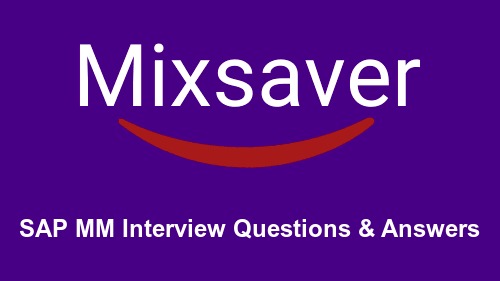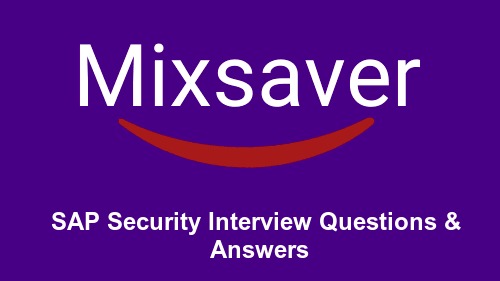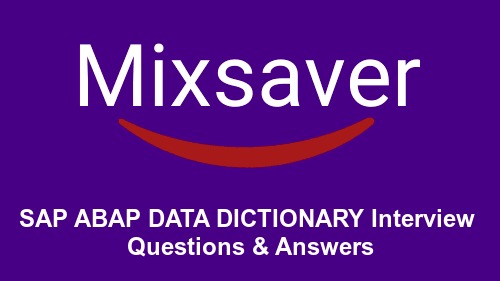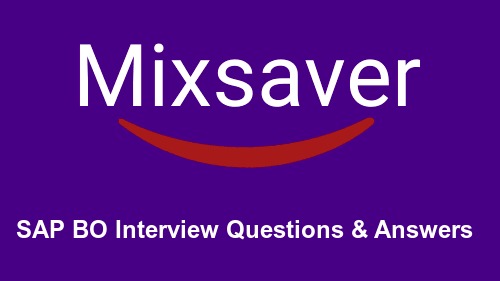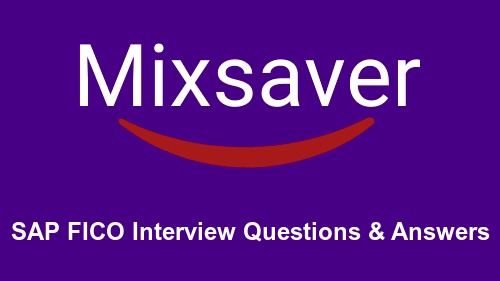1. What is the difference between a Purchase Requisition and a Purchase Order?
A PR is an internal document that sends a notification to the purchasing department when some material is service is required. PR can be generated by a department that needs any material or service.
A PO is a document sent to the vendor by the purchaser which is an official request of mentioned material or services. POs are generally binding on purchasers, though it depends on the terms and conditions mentioned in PO.
2. What are different Info Records types?
Different Info Record types are Standard, Consignment, Sub-Contracting, and Pipeline.
3. What is a consignment Stock?
The stock supplied by the vendor is in the purchasing company’s premises but the company has no liability for the same. The liability for the company will only arise one the goods are issued from the consignment stock for use. However, in this case, even before the use, purchasing company can check in system how much stock is lying in inventory.
4. What is Sub-Contracting cycle in MM?
In Sub-contracting, we send raw material or input material to sub-contractor and then receive the finished goods. A sub-contracting PO is created with item category ‘L’. Input material is sent to vendor for processing with movement type 541. When GR is done using movement type 101, movement type 543 takes place automatically and takes care of consumed material.
5. What is meant by Scales in MM?
When we maintain price in Info Records, we can make use of scales. It is used when price of a material is dependent on quantity purchased. For eg. For 500 pieces of material ABC, price is Rs. 10, however, if the order quantity is more than 500, price is Rs. 9. Scales are maintained in various master data like info record, quota arrangement etc. from where scales can be pulled in a Purchase Order.
6. How to Flag a material for deletion?
A material must be flagged for deletion before deleting it using Archive and Delete program. A deletion flag can be set at client level, plant level or storage location level. Whatever level you flag a material for deletion, it is flagged for deletion at all corresponding lower levels. Transaction MM06 is used to flag a material for deletion.
7. Can a material be used after flagging it for deletion?
Yes, even after flagging a material for deletion, it can be used till it is actually deleted. It will just trigger a warning message whenever the material is used. If you want a material to be blocked for any use with immediate effect, you should use a material status which is there in Basic View 1 for general level or in MRP 1 view for plant level blocking.
8. What is the function of OBYC?
OBYC is t-code used for configuring Automatic Account Posting.
Postings are made to G/L accounts automatically in the case of Inventory Management and Invoice Verification relevant to Financial and Cost Accounting.
9. What is valuation grouping code related to OBYC?
Valuation grouping code is used to group the valuation area, In SAP, we can have valuation level at Company code level or at plant level.
General practice is to use the valuation area at plant level, because valuation may differ from one plant to another. The valuation grouping code makes it easier to set automatic account determination. If we need to define common account determination for several valuation areas, we can assign same valuation grouping code to all those valuation areas. We can maintain the valuation group code in OMWD for various valuation areas.
10. What types of special stocks are available?
Various special stock types available in SAP are Consignment, Subcontracting, pipeline, project, sales order stock, Returnable transport packaging, stock transfer, and the third party.
11. What is the difference between Contracts and Scheduling Agreements?
A contract is a pre-determined long term agreement to supply material or service for a certain period of time. Specific delivery dates are not mentioned in the contracts. Contracts can be of two types: Value Contract or Quantity contract
In Scheduling agreements, we can enter scheduling lines which gives details of quantity that should be delivered on specific date. Plant must be entered in SA so that materials can be delivered at plant. These are generally used for materials whose requirements are predictable.
12. How can we create new transaction codes in SAP?
New transaction codes can be created using t-code SE93.
13. What are release procedures with and without classification?
Release Strategy with Classification:
PR can be released at header level as well as item level.
It can be used for both internal/external documents.
Can be set on any field available in structure CEBAN
Release Strategy without Classification:
PR can be released only at item level.
It can be used only for internal documents such as PR.
This strategy can be used only on 4 parameters which are Account assignment category, Plant, Material Group and value of PR.
14. What is meant by batches?
A batch is a subset of the total stock of a material. It represents a homogeneous unit which has unique specification. Normally, a batch is assigned to the quantity of material produced during a given production run. A batch number uniqueness can be assigned at any of the following 3 levels:
At client level: The same batch number can be assigned only once within the entire client.
At material and plant combination level: Same batch number can be assigned to material with different specification in each plant.
At material number level: A batch assigned to a material has the same specification for all plants where material is extended. Batch number can be reassigned with a different specification for each material.
15. How to handle free items in PO?
While creating PO, we can tick the item as free item in item overview section of PO. The price will be zero for free marked item.
16. What information is maintained in Accounting View of material master?
Accounting view is a plant specific view. Besides other information, it contains important information such as valuation class and price control. Valuation class helps in determining the relevant GL account used for account posting. It is also used while configuring OBYC settings. Price control indicator determines if material is maintained at Standard price(S) or Moving average price (V).
17. What is the use of Material types?
‘Material Types’ is used to group various materials based on some common properties. It helps in maintain material master data for a particular material. Using material types, we can control which all views are required for a material type, which fields are required or optional, the material number range etc.
18. What is the use of ‘Partner Functions’ for a vendor?
Partner Function is used to define responsibilities and duties of other business partners. Some partner functions are AZ(Alternate payee), CR(Carrier), OA(Ordering address), GS(Goods supplier), PI(Invoice presented by) etc.
19. What is the use of ‘Material Status’?
Material Status helps in determining the usability of a material. It is a 2-digit code which can be maintained as plant specific material status, cross-plant material status, and distribution material status.
20. What is the ‘Price Control Indicator’?
‘Price Control Indicator’ is maintained in accounting view and is used to determine how a material will be valuated. It can be Standard Price(S) or Moving Average Price(V). If the indicator is set to S, all inventory postings are posted at standard price maintained in material master. If there are variances in any transaction due to different price, the variance is posted in price difference account.
If price control indicator is set at V, goods received will be done at GR price. The moving average price will be adjusted in material master using weighted average formula. If goods movements or invoice receipts are posted using a price that differs from the moving average price, the differences are posted to the stock account.
21. What are various types of Stock transfer?
The physical movement of stock between different physical locations is called as ‘Stock transfer’. Stock transfer can be either a single step process or a two-step process.
Various Stock transfers are:
Inter Company (Company to Company)
Inter Plant/Intra Company (Plant to Plant)
Intra Plant (Storage location to Storage location)
22. What are various Stock Types?
In SAP, commonly used stock types are:
Unrestricted Stock (Stock that is available for use)
Restricted Stock
Quality Inspection Stock (Not the unrestricted stock but can be considered for MRP)
Blocked Stock (Stock rejected by quality or production)
GR Blocked Stock (Conditionally accepted stock. Not the unrestricted stock)
23. What are various procedures for counting Physical Inventory?
Physical Inventory procedures in SAP MM are as follows:
Periodic Inventory (All stocks are counted on a pre-determined date)
Continuous Inventory (stocks are counted continuously during the entire fiscal year)
Cycle Counting (Counting is done at fixed intervals)
Inventory Sampling (Randomly selected material stocks are physically counted on the balance sheet key date. If variances are small enough, it is presumed that the book inventory balances for the other stocks are correct.)
24. What is the use of ‘Split Valuation’?
Within a valuation area, sometimes, we need to valuate various stocks of a material separately. It can be because of different origin, quality, status, etc. We use split valuation in such cases. In this case, material is managed at several partial stocks which are sub-stocks of main material stock. Any transaction, relevant for valuation, is carried at this partial stock level. In accounting view, we define if we need split valuation for any material.
25. What are the various stock valuation methods?
Stock revaluation can be done by following three methods:
LIFO(Last In First Out): Materials received last are consumed first. You can assume example of elevator where people who enter last exit first!
FIFO(First In Firs Out): Materials received first are consumed first.
Lowest Value Method: Stocks are valued at their original price or the current market price whichever is lower.
26. How do you set ‘Automatic Account Assignment’ in MM?
Once OBYC settings are properly done, system finds the correct G/L account using the following data:
Chart of Accounts: Chart of Accounts is determined based on plant or company code used in transaction
Valuation Grouping Code: It is determined based on the valuation area. Valuation Grouping Code is maintained in t-code OMWD.
Transaction Key: eg. BSX, GBB etc. Transaction keys are determined automatically from the transaction (invoice verification) or the movement type (inventory management).
Account grouping /Account Modifier (only for offsetting entries, consignment liabilities, and price differences)
Valuation class of material or (in case of split valuation) the valuation type: The valuation class allows you to define automatic account determination that is dependent on the material. This can be achieved by assigning different valuation classes to the materials in material master (Accounting view) and by assigning different G/L accounts to the posting transaction for every valuation class
27. What are ‘Transaction Keys’ while setting OBYC?
Since each movement type is assigned to a ‘value string’ which in turn is identified with a transaction key, the goods movement determines the correct transaction key. Transaction Keys’ are pre-defined in the system to enable transaction postings in Inventory Management and Accounting (Invoice Verification). Examples of pre-defined transaction keys are:
BSX (Inventory Postings)
WRX (GR/IR Clearing Postings)
PRD (Cost/Price differences)
UMB (Revenue/Expenses from revaluation)
GBB (Offsetting entries in Stock postings)
BSX, WRX, and PRD are relevant for a GR with reference to a purchase order for a material with standard price control. The transaction key UMB is used when the standard price has changed and the movement is posted to a previous period. GBB is used to identify the GL account to post to as the offsetting entry to the stock account (when not referencing a purchase order) such as miscellaneous goods receipts, goods issues for sales orders with no account assignment, and scrapping etc.
28. What is a Business Area?
The business area is an organizational unit within financial accounting. It corresponds to a defined business segment or area of responsibility, to which value movements recorded in Financial Accounting can be assigned. It is usually derived automatically as it linked to other organizational units. For eg. Business area for a combination of plant and division is maintained by t-code OMJ7.
29. What is a Cost Center?
Cost Center accounting is used for controlling purposes. It is an organizational unit within a controlling area which represents a defined location of cost incurrence. For example, any department can be a cost center for recording all expenses incurred for that department.
30. What is a Profit Center?
Profit Center Accounting evaluates the profit or loss of individual, independent areas within an organization. Profit center is an organizational unit in controlling to recognize your profit. Profit center is attached to material master at plant level.
31. How to create Tax calculation procedure in MM?
Tax can be calculated for each line item of a PO separately based on the tax code. Earlier TAXINJ, which is a formula based tax procedure, was used. Now, TAXINN, which is a condition based tax procedure, is generally used. Tax procedure contains the condition type and necessary specification for each condition type. Account keys are assigned to condition types and these account keys determine the G/L to which the tax amount is to be posted(OB40). These account keys are maintained using t-code OBCN. (All these transactions are under Financial Accounting Global Settings >> Tax on Sales/Purchases >> Basic Settings). Tax codes are assigned to country codes and country are linked with tax procedure. Thus, based on tax code, corresponding tax procedure is determined and then calculation is done based on condition types in that tax procedure.
32. How is scrap material taken care of in sub-contracting?
Scrap can be maintained in BOM as operational scrap, component scrap, By-Product or Co-Product. Common practice is to maintain scrap as by-product and receive it back along with processed material.
33. How are the by-products taken care of in sub-contracting?
When you create BOM using CS01, we can maintain main components with + ve quantities and By Products / Scraps with - ve quantities.
When you make Goods Receipt for Subcontracting Purchase Order with 101 movement type, components are automatically consumed with movement type 543 By Products / Scrap are updated as stock provided to vendor movement type 545. Now we can receive this scrap/ By product back in company’s inventory using movement type 542 (reversal of 541) with t-code MB1B.
34. What are the commonly used movement types in Sub-Contracting process?
541 - Issues of goods from warehouse to subcontractoru2019s stock
542 - Reversals of goods issues from warehouse to subcontractoru2019s stock
543 - Consumption from subcontracting stock (Automatic updating during GR)
544- Co-products receiving
545- Goods receipt of by-products from subcontracting (Stock provided to vendor)
101 – Finished good/ Sub-Contracted good received after processing
35. What are accounting entries in standard sub-contracting process?
Accounting entries in standard sub-contracting process are as follows:
For finished goods received:
Debit stock account of assembly(FG) (BSX)
Credit Change in Stock (BSV)
For amount payable to vendor:
Debit SC/JW charges (FRL)
Credit GR/IR (WRX)
For material provided to vendor:
Debit Consumption Account of components (GBB-VBO)
Credit Stock account of components (BSX)
If there is a price difference and customization is done for accounting for price difference in subcontracting, PRD transaction key comes in picture.
36. What are the possible values of procurement type in Material Master?
Procurement type is maintained in MRP1 view of material master. This is a plant specific view as MRP is done at plant level. Various procurement types in material master are as follows:
In-house production (E)
External procurement (F)
No procurement
Both Procurement types (X)
37. What are the requirements for an ‘MRP Run’?
MRP should be activated in that plant
Master Data for MRP should be maintained (Planning Calendar etc.)
MRP data for material should be maintained
MRP1 view should be maintained (e.g.. Reorder point, Safety stock etc.)
MRP2 view should be maintained (e.g.. Plan delivery time etc.)
MRP can be run using MD03
38. What is a MRP Area?
MRP Area is an organizational unit for which material requirement planning can be carried out independently.
MRP Areas are of three types:
Plant MRP Area
MRP Areas for Storage Locations
MRP Areas for Subcontractors
After defining MRP areas, MRP area is assigned to material in material master.
39. What is MRP list?
The system creates MRP lists during the planning run. The MRP list always displays the future stock/requirements situation at the time of the last planning run. The MRP list is stored in the system until it is either deleted manually or replaced by a new list from a subsequent planning run.
40. What MRP procedures in Consumption Based Planning?
MRP procedures in CBP are as follows:
Reorder Point Procedure
Forecast based Planning
Time phased material planning
41. What is the difference between standard purchasing organization and reference purchasing organization?
Purchasing organization is an organizational unit within Logistics. A standard purchasing organization must be provided to one or more plants for which it is directly responsible for procurements.
A purchasing organization is assigned to reference purchase organization to avail conditions and centrally agreed contracts or release orders contained in the assigned reference purchasing organization
42. Why do we use document types in SAP?
Document types are used to distinguish the business transactions to be posted. It also helps in determining the account types to be posted and subsequent transactions to complete the process. Document types are defined at client level.
43. Can we receive the goods before the scheduled delivery date in scheduling agreement?
No, we cannot receive the goods before scheduled delivery date. GR can be posted on or after the scheduled dates. Though, SAP has provided some OSS notes to resolve this. (708973, 741385)
44. Can changes be made in PO once it is released?
This can be controlled by settings given in release indicator in PO release procedure. If it is a significant change, it will re-trigger approval cycle.
45. What is the use of ‘Info Update’ indicator in purchasing documents?
This indicator is used to decide if the info record is to be created/updated or not based on this purchasing document.
46. What is a Material Ledger?
A material ledger retains all transactions that relate to the purchase and use of materials for producing goods. Material ledger data is valuation and control data for a material in a plant for a specific posting period. Material ledger contains data for material movements that are relevant to the valuation of the material.
47. What is a ‘Return Delivery’?
Return Delivery is used if we want to return goods to a vendor for any reason such as bad quality, or bad packaging etc. In normal cases, return delivery is done by movement type 122. For creating return delivery, reason for return is a mandatory field.
48. How to deactivate a vendor so that it cannot be used for further transactions?
A vendor can be blocked at various levels as follows:
All Company Code
Single Company Code
All Purchasing Organization
Single Purchasing Organization
49. What is EAN?
An article can be carried in different units of measure. An European article number (EAN) is created as a unique indicator for each of these units of measure. The most important use of EANs within a company is to identify articles at the point of sale (POS) using the barcode.
50. What are basic tables used for Material Master?
Some of the basic tables used in Material master are:
MAKT: Material Descriptions
MARA: General Material Data
MARD: Storage Location Data for Material
MVER: Material Consumption
MARC: Plant Data for Material
MVKE: Sales Data for Material
MAST: Material to BOM link
MARM: Unit of Measurement
MBEW: Material Valuation
